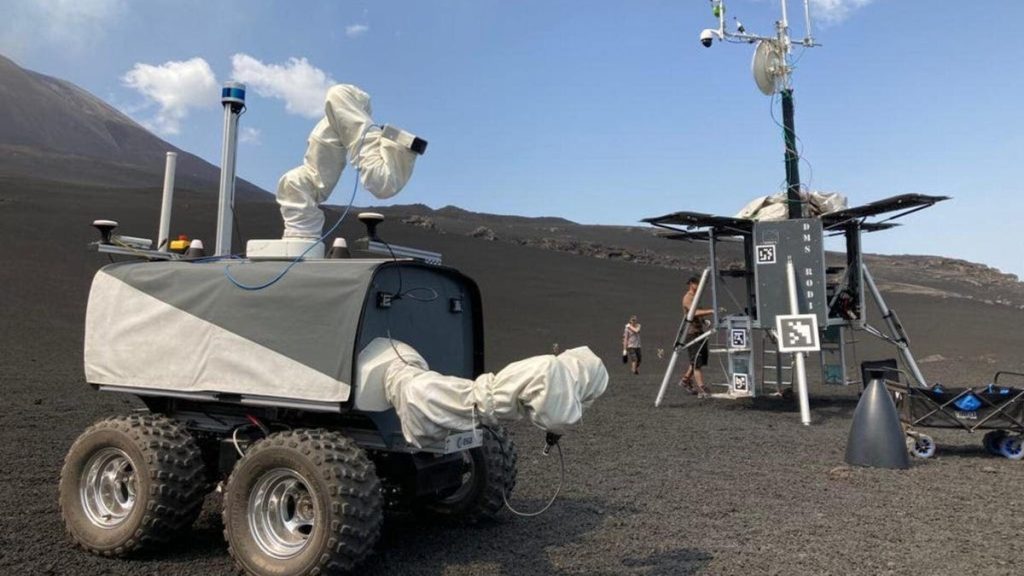

While working outside a hotel room in Italy, astronaut Thomas Reiter commanded a four-wheeled robot to pick up rocks from the surface of an active volcano on the east coast of Sicily, and he did so while role-playing as if he were in orbit around the moon.
The four-day simulation is part of the European Space Agency’s (ESA) preparations for a future mission to the moon, in which it plans to land a rover on the lunar surface to collect rock samples. The craft, as part of the upcoming Artemis missions, will be directed by a team on Earth, as well as an astronaut on board. Moon Gatea planned space station orbiting the moon.
Although not quite the Moon, the volcanic surface of Mount Etna served as a counterpart to the Moon’s surface. The Interact four-wheeled, two-armed rover, modified to fit the rugged slopes of the volcano, explored the rugged terrain alongside two other rover vehicles, the Lightweight Rover Units 1 and 2, belonging to the German Aerospace Center. In addition, a fixed lunar lander provided the rover with wifi and power, a drone mapped the surface, and a centipede-like crawler called Scout served as a relay between the Interact rover and the probe. Scouting was introduced by the Karlsruhe Institute of Technology.
During the four days, ESA astronaut Reiter ordered the rover to pick up rocks using controls placed in a hotel room in Sicily. The Interact vehicle was also guided by controllers in the rover’s control room, which were set up in a different hotel room since the controllers and the astronaut would be physically separated during an actual mission.
The rover itself was about 14 miles (23 kilometers) from the hotel and about 8,500 feet (2,600 meters) high on Mount Etna. To make the exercise more realistic, the team added one second of signal delay to the control system to simulate the time it would take for commands to reach the lunar surface from the Moon Gate. When the rover picks up rocks from the volcano, Reiter could sense what the rover’s clutch was feeling from the remote control – an added dimension of the European Space Agency’s sampling process.

“We’ve learned a lot about the collaboration between a ground controller on Earth and the crew aboard a space station orbiting the Moon, both of whom are operating a surface-to-surface rover – this ‘combined’ operation could be very effective – much more efficient than if either side were,” Reiter said in a statement. a statement.
The system has been in development for more than a decade, beginning as a joystick that an astronaut could control while in orbit, according to the European Space Agency. The four-day simulation represents the first time that the Interact rover has been tested during a mock outdoor setup. By the end of the four days, the rover had successfully returned the rock samples to the lunar lander. The three vehicles also worked together to create an array of antennas across the simulated lunar surface to simulate a radio astronomy station on the Moon. Interestingly, these antennas have already managed to pick up a radio explosion from Jupiter – the result of the passage of the volcanic moon Io through the planet’s magnetic field.
By the end of the simulation, the European Space Agency found that the rover’s controls would likely be too cumbersome for astronauts aboard the future Lunar Gateway.
“What we soon discovered was that continuous remote monitoring was very difficult for the astronaut, so we added features to relieve some of the pressure – equivalent to the assistive driving that modern cars provide,” said Thomas Krueger, head of the human division at ESA’s Interaction Lab. Android, in a statement. “For example, an operator can point to a location and let the rover decide for itself how to get there safely. Its neural network has been programmed to identify rocks of scientific value for itself.”
This certainly seems much easier and certainly more appropriate for the future age of Artemis. The European Space Agency hopes to launch the rover and put the control system into practice by the end of this decade.
more: Microbes may hide the secret to making more powerful rocket fuel.





More Stories
In Greece Porsche 911 50th Anniversary – How much does it cost?
PS Plus: With a free Harry Potter game, the new season begins on the service
Sony set to unveil PS5 Pro before holiday season – Playstation